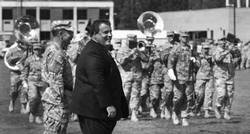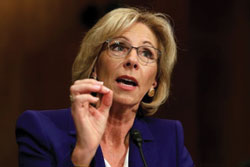As the editor of the politics section here at the Outlook, I find it important to stress that the contents this article will go over may be outdated information by the time this story is published. The situation currently developing between the Russian and Ukrainian governments is fast moving, and I fully recommend checking major media outlets for more consistent updates. Despite not publishing daily, the politics section at The Outlook will include a weekly update on these important events.
On Feb. 21, 2022, Russian President Vladimir Putin ordered the deployment of Russian forces into the Ukrainian Oblasts of Donetsk and Luhansk, two territories that form part of the Donbas region and have been under the occupation of ethnic Russian separatist forces since 2014. The deployment came soon after Vladimir Putin recognized the breakaway Donetsk People’s Republic (DPR) and Luhansk People’s Republic (LPR) as independent states. The troop deployment has been categorized by the Russians as one of a peacekeeping nature, while the United States and the West have called it the beginning of an invasion and a flagrant violation of Ukrainian sovereignty. Within all this news, many may be asking: how did we get here?
The history of the conflict is a long and complicated affair. The true beginnings date all the way back to 1954, when then Soviet Premier Nikitia Khruschev transferred the ownership of Crimea from the Russian SFSR to the Ukrainian SFSR. During this period, this move was seen as nothing more than symbolic, as both Russia and Ukraine were members of the Soviet Union and therefore under the say of the Soviet central government. When the Soviet Union collapsed in late December of 1991, the issues of this transfer, alongside how the post-Soviet world was going to move forward, became apparent.
With the collapse of the Soviet Union, the world saw the independence of 15 new states, one of them being a Russia that, historically speaking, was in its weakest position in centuries. How Russia was to move forward with this new situation was a question many in the world pondered over. Within the Russian government, the concept of the Near Abroad was born. The Near Abroad includes all former Soviet states that the Russian government feels is part of its sphere of influence, and therefore no outside intervention is to be allowed, otherwise Russian national security would be at risk. Ukraine is included in this arrangement, and it is important to note that according to last available census data from 2001 roughly 17% of Ukraine’s population is ethnic Russian, who live mostly in the Eastern and Southern half of the country. Despite ethnic Russians being 17% of the population, 30% of the total population’s first language is Russian, a matter that is of relevance for Russia’s involvement in the country.
Several issues defined the Russian-Ukrainian relationship of the 1990s and early 2000s. The first and most pressing was the matter of former Soviet nuclear weapon stockpiles on Ukrainian soil. While Ukraine would not be able to immediately operate them due to their control systems being present in Moscow, there were concerns by both the West and Russia that Ukraine could one day reconfigure these weapons and become a nuclear weapons state. This issue was resolved through the Budapest Memorandum, where Ukraine agreed to cede its weapon stockpile in exchange for guarantees by Russia and the other signatories to, in essence, respect Ukrainian territorial integrity. The second most pressing issue was the status of the Russian Black Sea Fleet, the successor to the Soviet Black Sea Fleet, which was based in Crimea. Diplomacy once again triumphed, with Ukraine leasing Russia access to naval facilities in the Crimean port of Sevastopol.
Throughout the rest of the 90s and early 00s, Russia and Ukraine engaged in several gas disputes. Further strains on the relationship came with the formation of the GUAM economic organization by Ukraine and others, which Russia saw as a threat to its CIS economic institution, alongside the events surrounding the 2004 Orange Revolution, which saw pro-Western President Viktor Yushchenko elected to the Presidency against pro-Russian Viktor Yanukovych. In the background of all these developments, NATO and the EU had expanded eastward into territories formerly controlled by the Soviet Union and Warsaw Pact, heightening Russian anxieties about their strategic position, placing further strategic importance onto Ukraine.
Despite his defeat in 2004, in 2010 Viktor Yanukovych was elected to the Presidency. In the early years of his administration, there was a belief amongst the Russians and Ukrainians that the issues in their relationship could be worked out. Russian access to the Sevastopol naval facilities were extended and ties began to slowly warm. However, the most pressing issue was that of Ukraine signing a free-trade and association agreement with the European Union, an idea which arose during Yanukovych’s administration in the year 2012. At the time, Russia had warned of dire consequences for Ukraine should this treaty come into effect. As aforementioned, the West was expanding its institutions (EU/NATO) into states not only formerly part of the Warsaw Pact, but also states considered part of the Near Abroad. In the minds of Russian policymakers, Ukraine was an absolute redline and there was no choice but to ensure its alignment. This is highlighted through the Sergey Glazyev tapes, which detailed Russian plans to coerce Ukraine. In August 2013, Russia’s customs agency barred the import of Ukrainian goods as a response to the treaty negotiations. This led to a decline in Ukrainian economic activity, and ultimately ended the project of an association and trade agreement in 2014.
News of the failure of the talks sparked outrage amongst the Ukrainian population, who took to the streets of Kiev in protest in February 2014. The event has been coined the Euromaidan, named after the Maidan Nezalezhnosti, the central square within Kiev, where this protest began. The protests eventually evolved into an anti-government, pro-Western demonstration, with the movement dubbed “United Ukraine.” The results of this event are far reaching. Yanukovych’s government was overthrown, the Party of Regions, Ukraine largest party from 2006-2014, was banned. A new pro-Western government installed, and the Russian military intervened in Ukraine, which included the annexation of Crimea and the beginning of the conflict between the Ukrainian government and Russian separatists in the country’s east, referred to as the Donbas War. Crimea is important to Russia due to the warm water port in Sevastopol and the ability to project power into the Black Sea, a prominent Russian strategic interest. Since these events, Ukraine has positioned itself closer to the West, with aspirations to become a NATO and EU member, further straining the relationship with Russia to the brink of outright conflict.
In September 2014, it was determined that a diplomatic resolution had to be reached to resolve the conflict in the Donbas. The original document, then known as the Minsk Protocol, was drawn up by Ukraine, Russia, the Organization for Security and Cooperation in Europe (OSCE), while France and Germany mediated, together forming the “Normandy Format.” The agreement attempted to establish a ceasefire, but this effort failed. In February 2015, a revised agreement was put forward, dubbed Minsk II. Minsk II provisions included a ceasefire, the withdrawal of heavy weapons from the immediate front line between Ukraine and the rebels, constitutional reform in Ukraine to grant autonomy to certain Donbas regions, the release of prisoners of war, and the restoration of control of the state border of Ukraine to the government in Kiev. The agreement significantly reduced fighting, but it did not come to a complete end. The constitutional reforms were never implemented and Ukraine never regained control over its state borders in Donbas. This status quo pushed the issue into a state of frozen conflict, to which it remained up until the evening of February 21, 2022.
As aforementioned, the state of frozen conflict has been broken by the official deployment of Russian forces into the Donbas region of Ukraine. As reported by the Business Insider on Feb. 18, Russia has deployed upwards of 190,000 troops to the Ukrainian border, including forces stationed in neighboring Belarus. The morning as of writing, February 22, 2021, President Vladimir Putin received the permission of Russia’s legislature to deploy the Russian military abroad. In response to Russia’s deployment, the United States is set to levy further, tiered sanctions on Russia, while Germany canceled the certification of the strategically important Nord Stream 2 natural gas pipeline. The United States has also submitted to the UN an alleged list of Russian targets in Ukraine, which includes dissidents that would be sent to detention camps in the event of invasion. The US has also warned the operation in the Donbas is only the beginning of what will be a broader Russian invasion. What will happen in the future the Outlook will not speculate on, but will again remind readers that this situation is extremely fluid and recommends following major news outlets for the updates.


